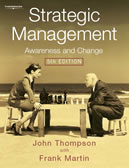|
Product Information:
|
Case StudiesAll the cases on the web site have been written specifically for classroom discussion and they should not be taken to reflect either effective or ineffective management. Some have been written with the full co-operation of the companies concerned; others rely more substantially on other published sources. The copyright in every case lies with the relevant author. The cases cover specific issues in strategy, as explained in these brief abstracts. Although some of them were written a few years ago, they are all still relevant for teaching purposes. Some of them are complemented by shorter Minicases in the Strategic Management text and the subsequent progress of all of them can be readily tracked on the Internet - although clearly this is not required for teaching the cases themselves. The links below will take you to the abstracts for each case. To access the pdf files for the complete cases, click on the links below each abstract. Teaching Notes are available for these case studies, on the password protected lecturer area of this website.
The National Trust It is an ideal ‘first case’ for a strategy course as it deals essentially with core strategic management principles. Access complete case study here P&O, Princess and the International
Cruise Industry The following comments summarise the key questions being addressed: Mike Moulin was distracted as he looked out over the calm, blue Caribbean waters. He was soon to go home on leave – but afterwards he would not be returning to this ship. His employer, Princess Cruises, had invited him to be the first Captain of Grand Princess, the largest cruise ship in the world and due for her maiden voyage in Summer 1998. Grand Princess would split her cruising year between the Caribbean and Mediterranean – her choice of destinations limited by her sheer size. Captain Moulin knew just how dependent a cruise ship is on its staff and wondered whether the issues would be any different on the first Princess ship to require a crew of over 1000 people. Since this case was written P&O Princess has been acquired by industry leader Carnival Cruises. This story is documented in a separate case (also written by John Thompson) which is available from the European Case Clearing House. Access complete case study here Tesco Price cutting, an important competitive strategy in retailing, does not truly distinguish one food retailer from another, as price cuts can be followed by rivals, although creative advertising can suggest a price differential when one really does not exist. Supply-chain cost savings, also facilitated by IT, however, can be an important source of advantage and improved profitability. This case looks at how Tesco exploited IT in the early 1990s to drive competitive advantage. Since the case was first written in 1996 events have moved on, but the basic strategic issues raised here remain pertinent and relevant. Tesco, for example, now shares live sales information with its suppliers and, by embracing IT themselves, more and more suppliers are linked electronically to Tesco. Again using the power of the Internet, e-markets allow any retailer to post up ‘confidential’ information but limit access to it through password-driven ‘firewalls’. Going beyond the advantages discussed in this case, the Internet allows retailers to invite suppliers to engage in bids or auctions when either the retailer has a specific shortage or a supplier has excess inventory. This case has two themes: • the use of information technology by Tesco to strengthen its competitiveness, and • the role of information technology in forging strategic linkages between Tesco and its distributors and suppliers. Information technology has both reduced costs and strengthened Tesco’s competitiveness by improving its overall level of customer service. Access complete case study here. It is the study of the growth of an entrepreneurial
company and how the need for cash to fund expansion affected
the strategic development. Virgin can usefully be studied alongside the Thorn EMI case. Access complete case study here The Sony Corporation Sony has always sought to develop unique products rather than copy other companies. Although profitable, profitability per se has not been the driving objective. Sony has invested in research and development at a rate above the average both for its industry and for Japan. Technologists are seen as a critically important resource and allowed freedom to work within relatively open-ended briefs. However, the company has come under enormous pressure as it has struggled to remain a leader in the changing world of consumer electronics and, as a result, there have been major changes in its strategies and structure in the 1990s and again in the early 2000s. This case study traces the growth, development, successes and setbacks of The Sony Corporation. It encapsulates issues of corporate and competitive strategies, structural evolution and the Japanese style of management. Sony’s strategy of diversification into the American entertainment industry is examined in detail. The case deliberately stops before The Sony PlayStation was launched, taking Sony in a fresh direction, and, as a consequence, it does not deal with the subsequent growth of DVD technology. Access complete case study here Sony PlayStation 2 The importance of The PlayStation to Sony cannot be underestimated and this case invites discussion of how Sony might develop PlayStation 3 whilst Microsoft works on X-Box 2. Access complete case study here C & J Clarks Access complete case study here |
